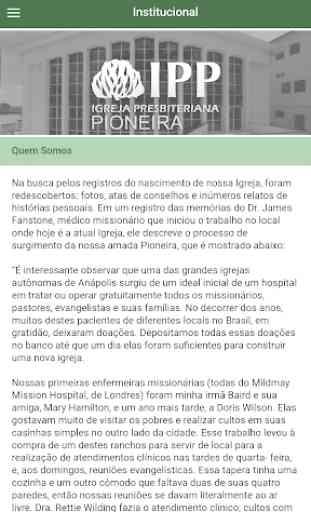IPP
You now have access to newsletters, hymnal, songs, bible, news and more at your fingertips.
With the area reserved for members you can still access the church contact list, mark counseling, submit prayer requests, conduct registration at events and EBD.
-
In search of the birth records of our church, they were rediscovered: photos, council minutes and numerous reports of personal stories. In a record of Dr. James Fanstone memories, missionary doctor who began work on the site in what is now the Church today, he describes the emergence process of our beloved pioneer, which is shown below:
"It is interesting to note that one of the great autonomous churches of Annapolis emerged from an initial hospital ideal to treat or operate free all missionaries, pastors, evangelists and their families. Over the years, many of these patients in different locations in Brazil, in gratitude, left donations. We put all these donations in the bank until one day they were enough to build a new church.
Our first missionary nurses (all of the Mildmay Mission Hospital, London) were Baird my sister and her friend, Mary Hamilton, and a year later, Doris Wilson. They loved to visit the poor and hold services in their simple houses on the other side of town. This work led to the purchase of one of these ranches place to serve for conducting clinical treatments in Wednesday afternoons and on Sundays, evangelistic meetings. This tapera had a kitchen and another room that was missing two of its four walls, so our meetings got on literally outdoors. . Dr. Wilding was Rettie clinical care; services with lamp lighting were held on Sunday evenings and needy people of the neighborhood helped build the "little church" of the hospital in place of the old ranch. But the time came when a larger site was necessary. Those donations accumulated in the bank were used to build the temple "(FANSTONE, 1972, p. 134)
The ranch built around the 30s, known as the "little church of Dr. James Fanstone" had been established as the place to "give injections in lepers" and hold services. It is said that young
preachers were trained in the services performed on site. With the growth of evangelistic work realized the need to expand the pastoral care for the people who participated in the worship there. Dr Fanstone, conscious of this responsibility, asked the Presbyterian Church of Annapolis, the incorporation of evangelistic work in their activities. Thus, on December 12, 1963, the Presbyterian Church of Annapolis, laced his ways with ours. Three months later, the Council designated the Elder Ulisses Borges de Oliveira as "in charge of the work in the little church." At the end of the same year, on 29 December, the Council unanimously adopted the emancipation of the "little church", and the Rev. Pericles Gonzaga, the first pastor of our church. On March 20, 1965, we were officially called the Second Presbyterian Church. And in August of that year, the name was changed to Pioneer Presbyterian Church. It is said that the notary did not accept the name of Second Church because there is no record of any other church named as First Presbyterian Church in Annapolis, so it was changed to Pioneer for well express the ideal of a church built on projects social and, especially, to be a living witness of the Gospel.
Over those 50 years, we are the dream of the fruit of God in the life of a man, a family, a group of nurses and a local church. A born Church to bless people obeying what Mark 16:15 says: "Go into all the world and preach the gospel to every creature."
With the area reserved for members you can still access the church contact list, mark counseling, submit prayer requests, conduct registration at events and EBD.
-
In search of the birth records of our church, they were rediscovered: photos, council minutes and numerous reports of personal stories. In a record of Dr. James Fanstone memories, missionary doctor who began work on the site in what is now the Church today, he describes the emergence process of our beloved pioneer, which is shown below:
"It is interesting to note that one of the great autonomous churches of Annapolis emerged from an initial hospital ideal to treat or operate free all missionaries, pastors, evangelists and their families. Over the years, many of these patients in different locations in Brazil, in gratitude, left donations. We put all these donations in the bank until one day they were enough to build a new church.
Our first missionary nurses (all of the Mildmay Mission Hospital, London) were Baird my sister and her friend, Mary Hamilton, and a year later, Doris Wilson. They loved to visit the poor and hold services in their simple houses on the other side of town. This work led to the purchase of one of these ranches place to serve for conducting clinical treatments in Wednesday afternoons and on Sundays, evangelistic meetings. This tapera had a kitchen and another room that was missing two of its four walls, so our meetings got on literally outdoors. . Dr. Wilding was Rettie clinical care; services with lamp lighting were held on Sunday evenings and needy people of the neighborhood helped build the "little church" of the hospital in place of the old ranch. But the time came when a larger site was necessary. Those donations accumulated in the bank were used to build the temple "(FANSTONE, 1972, p. 134)
The ranch built around the 30s, known as the "little church of Dr. James Fanstone" had been established as the place to "give injections in lepers" and hold services. It is said that young
preachers were trained in the services performed on site. With the growth of evangelistic work realized the need to expand the pastoral care for the people who participated in the worship there. Dr Fanstone, conscious of this responsibility, asked the Presbyterian Church of Annapolis, the incorporation of evangelistic work in their activities. Thus, on December 12, 1963, the Presbyterian Church of Annapolis, laced his ways with ours. Three months later, the Council designated the Elder Ulisses Borges de Oliveira as "in charge of the work in the little church." At the end of the same year, on 29 December, the Council unanimously adopted the emancipation of the "little church", and the Rev. Pericles Gonzaga, the first pastor of our church. On March 20, 1965, we were officially called the Second Presbyterian Church. And in August of that year, the name was changed to Pioneer Presbyterian Church. It is said that the notary did not accept the name of Second Church because there is no record of any other church named as First Presbyterian Church in Annapolis, so it was changed to Pioneer for well express the ideal of a church built on projects social and, especially, to be a living witness of the Gospel.
Over those 50 years, we are the dream of the fruit of God in the life of a man, a family, a group of nurses and a local church. A born Church to bless people obeying what Mark 16:15 says: "Go into all the world and preach the gospel to every creature."
Category : News & Magazines

Related searches



Used